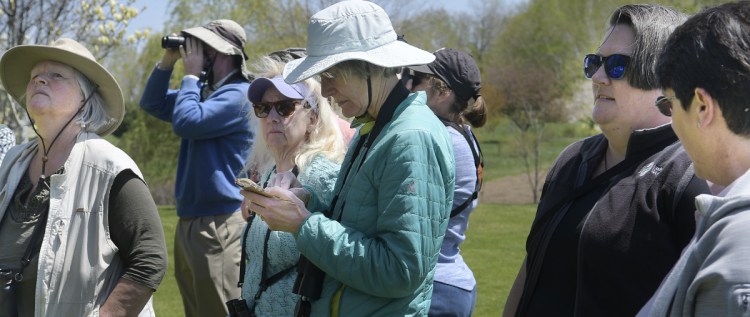AUGUSTA — Local birdwatchers were used to seeing eastern meadowlarks in the eastern section of Viles Arboretum.
The birds, whose gold bellies feature a distinct V-shaped patch of black feathers, often breed in grasslands and meadows, like the kinds that cover the 224-acre arboretum on the east side of Augusta.
Recently, though, local birdwatchers haven’t seen much of the meadowlark. And without concrete data, they’re not sure whether the seeming decline is indicative of a permanent change.
“We don’t know,” said Glenn Hodgkins, one of the area’s more active birders.
Now, state wildlife officials are launching a project that will enlist the help of birdwatchers across the state and could help document what’s happening to the populations of meadowlarks, along with many other species.
That project, the Maine Bird Atlas, is recruiting volunteers to systematically collect data on birds that are breeding and wintering here. On Sunday, almost 30 local birders came to an information session about the project, which was held at Viles Arboretum.
The data, which will be collected from 2018 to 2022, will be plugged into web-based mapping software and eventually published in a book and an online atlas.
The Maine Department of Inland Fisheries & Wildlife hopes the final product will guide its efforts to protect endangered species and fund conservation projects. The last time the state compiled such a resource was more than 20 years ago, between 1978 and 1983.
“So we’re a little behind,” Doug Hitchcox, a staff naturalist at Maine Audubon, said during Sunday’s information session.
Maine Audubon, a conservation organization based in Falmouth, has partnered with state wildlife officials on the project. For more than three hours, Hitchcox explained how the would-be citizen scientists could adopt one of the designated survey areas that have been established across the state, determine which species of birds are breeding there, record the data and plug it into an online portal.
Organizers are now trying to recruit 2,000 volunteers who can commit 20 hours to the project over the next five years.
While the old Maine bird atlas has value, Hitchcox said the new one will provide a more comprehensive snapshot of bird populations around the state, which should guide future studies and conservation efforts.
He pointed to the example of American kestrels, a small falcon also known as the “sparrow hawk” that has been declining in Maine, at least partly because the reduction in agricultural land has diminished its habitats. Soon after the new atlas is completed, state officials will devise a new 10-year plan for wildlife conservation.
“If we can show that kestrels are declining in every part of Maine, they can step in,” Hitchcox said.
At the end of the session, Hitchcox took some of the attendees on a short tour through the arboretum, where bluebirds, brown-headed cowbirds and tree swallows were flying about. They appeared to be taking advantage of the sunny spring afternoon, collecting brush and scoping out possible nesting areas.
Much of Hitchcox’s instruction was focused on how volunteers, once they have signed up to study an area, can be systematic and accurate in their observations of birds. Just because some species are singing doesn’t mean that they’re necessarily trying to attract mates.
Hitchcox handed out a list of species that shows the date ranges when they are commonly expected to be mating. He also reassured less experienced birdwatchers and noted that organizers of the project will be checking the data to make sure it doesn’t have any glaring problems – such as any reports of a tropical species breeding in Maine.
“Right now, I could submit that there is a toucan in Portland carrying nesting materials,” he said. “It would first be flagged because it’s a toucan.”
He also explained in detail some of the intricacies of the mapping software, which can be accessed on a computer and a smartphone.
If volunteers do not want to enter the data into computers, they have the option of recording the data on print forms and sending it to the organizers. That option was of interest to the members of an Amish community around Holden, Hitchcox said.
While the atlas project could help document the populations of more threatened species, Hitchcox said that it also will force volunteers to observe the behavior of less-glamorous species that many take for granted, such as pigeons and mourning doves.
“There are species that are already identified as endangered or threatened,” he said. “But this is a good opportunity to take the pulse of these other species, so we can see how they’re doing. Who knows what we’ll find?”
Charles Eichacker can be contacted at 621-5642 or at:
ceichacker@centralmaine.com
Send questions/comments to the editors.




Success. Please wait for the page to reload. If the page does not reload within 5 seconds, please refresh the page.
Enter your email and password to access comments.
Hi, to comment on stories you must . This profile is in addition to your subscription and website login.
Already have a commenting profile? .
Invalid username/password.
Please check your email to confirm and complete your registration.
Only subscribers are eligible to post comments. Please subscribe or login first for digital access. Here’s why.
Use the form below to reset your password. When you've submitted your account email, we will send an email with a reset code.